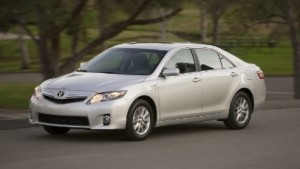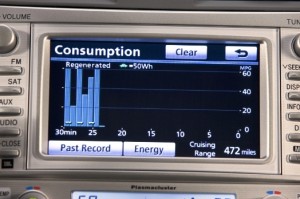The Toyota Camry hybrid is a technological triumph that produces significant increases in fuel economy, particularly during urban and suburban driving that many of us face. However to achieve this Camry hybrid employs a number of sophisticated systems that affect the performance and feel of the family car.
These systems result in driving aspects that differ from those of any non-hybrid car you’ve ever driven, including the continuously variable transmission, the start/stop engine and regenerative braking. As Toyota’s mainstream entry in the U.S. family car market, this might present a customer satisfaction challenge as sales volumes increase and the driving audience widens. competent car.
Unlike the hugely successful Prius with its large following of hybrid technology geeks – and I mean that as a complement to the geeks – Camry is a car that has been accepted largely because drivers can ignore it. Buy a Camry, change the oil once in a while, and keep driving it. Camry is the perfect automotive appliance.
However, there’s no ignoring the operation of the Camry hybrid system, if only because the pictorial energy monitors adjacent to the speedometer and on the navigation screen constantly tell you what’s going on and how efficiently you are driving. Annoying at first, the meters soon challenged me to increase my driving efficiency, which I did by following the monitors. Studies have shown that such efficiency “video games” do produce real world fuel economy improvements.
Over the years I have spent a lot of time behind the steering wheel of various Camry models as the car evolved. I liked them all, albeit occasionally nit picking what in my younger days seemed a too soft ride. The latest iteration of the Toyota Camry is no exception. This sixth generation Camry is classified by the EPA as a midsize car with more than 116 cubic feet of passenger and trunk volume. In ride and handling, the car remains soft, lacking the steering responsiveness and body control of ride motions (and the harshness and head toss) of say a Honda Accord, but this is “boring” in a good way for harassed commuters who don’t want to be aware of or engaged with the machinery.
The current Camry is a large evolution from the Camry that was introduced in 1982 as a compact replacement for the Corona. Following an industry trend (or curse?), Camry has been growing ever since gaining in size and weight, entering the midsize category in 1992. As the best-selling passenger car in the U.S. for eight years running, and 12 of the past 13 years, Camry remains the benchmark for an extremely competitive class. Camry defines comfort, performance and intelligent but unobtrusive design. It’s now also available for the last few years with Toyota’s Hybrid Synergy Drive.
Here’s where the debate begins.

Following an industry trend (or curse?), Camry has been growing ever since gaining in size and weight, entering the midsize category in 1992.
When you start the hybrid Camry the electronic gauges activate in near silence. It doesn’t “start” in the traditional sense until you step on the accelerator with the transmission in drive. That’s when the stop-start system kicks in with a noticeable floorboard vibration and a slight rumble as the 2.4-liter four-cylinder gas engine comes to life.
Well, after a couple of days I got used to this lurch, rumble. Camry’s stop/start prevents wasted energy from idling, and an electric motor helps when accelerating from a dead stop – the two times when a conventional vehicle’s engine is the most inefficient. I’ll spare a fuller discussion of Newton’s F=MA here, but Toyota engineers understand and are working with fundamental physical laws to great effect. In fact, I am now driven crazy (crazier?) whilst sitting stopped and idling in traffic in brand X, Y, or Z getting ZERO mpg. This start/stop system is largely responsible for the Camry hybrid getting an astonishing 36 mpg on my urban-suburban test drive route.
For compassion consider that in the same mixed suburban and highway driving, I got 21 to 22 mpg on average from a Camry XLE V6 powered sedan. Yup, a repeatable route and 22 mpg versus 36 mpg with equivalent performance – oh, what a good feeling to borrow from an old Toyota marketing campaign.
Official EPA ratings here are 19 city, 28 highway for the gasoline only version. A better way to look it is figuring that you will use 3.3 gallons of regular unleaded gasoline for every 66 miles that click off on the electronic odometer under EPA’s worst case in the V6 powered conventional Camry. Nice car, but no mileage cigar here.
With the Camry hybrid, EPA fuel economy estimates are 34 mpg highway, 33 mpg city and 34 mpg combined. I beat them all – in my test loop. (One mile equals 1.61 kilometers, one gallon equals 3.79 liters) Conclusion? I can learn to live with the start/stop system, and I might be in love with it, lurch-rumble quirks and all.
The other Camry hybrid fuel economy benefit accrues from its “full hybrid” design that allows for brake recharging of the battery – converting some thermal braking energy to reusable chemical energy for the electric motor that runs during starts and acceleration. I’ll skip Newton again, but a full hybrid vehicle – using a technology that Toyota unquestionably leads in – runs on electric drive at very low speeds, on a combination of the gasoline engine and electric motor(s) in traffic, and on gasoline power alone at highway speeds. This makes for some interesting and, once again, sometimes noticeable transitions between modes while control computers coordinate the electric motor and gasoline engine for what programmers think is an optimal balance performance, stability, fuel economy and lower emissions. And to be fair Toyota has had some customer satisfaction issues here requiring tweaks to its software.
In the past the transition from regenerative braking to hydraulic braking at about 8 mph was not always transparent to drivers. Under certain conditions, the driver needs to press harder on the brake pedal to obtain the same stopping performance that the regenerative system working in conjunction with the hydraulic brakes initially provides. In the Camry Hybrid I did not experience this, but the roads were dry and largely free of surfaces with different coefficients of friction during my testing.
Camry was also planned before the new, higher fuel efficiency standards now taking hold. They require new cars to average 35.5 miles per gallon by 2016, a 30% increase. Toyota in effect is already there with this Kentucky-built sedan. And unlike other fuel saving technologies being touted by suppliers, the car is a bargain. The sticker on the test car was $33,204 with delivery. However, if your eliminate the upgraded navigation and DVD package, $2,960, or the leather seats, $1,295, or the moonroof, $890, the car lists under $30,000. And that’s before any incentives that Toyota is currently running in an attempt to prop up its marketshare after image damaging unintended acceleration recalls
So. if you are looking for fuel economy, the Camry Hybrid equipped with Toyota’s extremely sophisticated Hybrid Synergy Drive – and certified as an Advanced Technology Partial Zero Emissions Vehicle or AT-PZEV- has a lot to offer, if you can live with the quirks.



